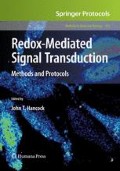Abstract
Functioning and efficient cell signaling is vital for the survival of cells. Over the course of many years, various components have been identified and recognized as crucial for the transduction of signals in cells. Many of the mechanisms allow for a relatively rapid switching of signals, on or off, with common examples being the G proteins and protein phosphorylation. However, recently it has become apparent that other modifications of amino acids are also important, including reactions with nitric oxide, for example, S-nitrosylation, and of particular relevance here, oxidation of cysteine residues. Such oxidation will be dependent on the redox status of the intracellular environment in which that protein resides, and this will in turn be dictated by the presence of pro-oxidants and antioxidants. Here, the chemistry of redox modification of amino acids is introduced, and a general overview of the role of redox in mediating signal transduction is given.
Access this chapter
Tax calculation will be finalised at checkout
Purchases are for personal use only
References
Hancock, J. T. (1997) Superoxide, hydrogen peroxide and nitric oxide as signalling molecules: their production and role in disease. Br J Biomed Sci 54, 38–46.
Dröge, W. (2002) Free radicals in physiological control of cell function. PhysiolRev, 82, 47–95.
Neill, S. J., Desikan, R., and Hancock, J. T. (2002) Hydrogen peroxide signalling. Curr Opin Plant Biol, 5, 388–395.
Colavitti, R., and Finkel, T. (2005) Reactive oxygen species as mediators of cellular senescence. IUBMB Life, 57, 277–281.
Vanderauwera, S., Zimmermann, P., Rombauts, S., Vandenbeele, S., Langebartels, C., Gruissem, W., Inzé, D., and Van Breusegem, F. (2005) Genome-wide analysis of hydrogen peroxide-regulated gene expression in Arabidopsis reveals a high light-induced transcriptional cluster involved in anthocyanin biosynthesis. Plant Physiol, 139, 806–821.
Ullrich, V., and Kissner, R. (2006) Redox signaling: bioinorganic chemistry at its best. J Inorg Biochem 100, 2079–2086.
Neill, S. J., Desikan, R., and Hancock, J. T. (2003) Nitric oxide signalling in plants. New Phytol 159, 11–35.
Perazzolli, M., Romero-Puertas, M. C., and Delledonne, M. (2006) Modulation of nitric oxide bioactivity by plant haemoglobins. J Exp Bot 57, 479–488.
Salmeen, A., Anderson, J. N., Myers, M. P., Meng, T. C., Hinks, J. A., Tonks, N. K., and Barford, D. (2003) Redox regulation of protein tyrosine phosphatase 1B involves a novel sulfenyl-amide intermediate. Nature 423, 769–773.
Van Montfort, R. L., Congreve, M., Tisi, D., Carr, R., and Jhoti, H. (2003) Oxidation state of the active-site cysteine in protein tyrosine phosphatase 1B. Nature 423, 773–777.
Lindermayr, C., Saalbach, G., and Durner, J. (2005) Proteomic identification of S-nitrosylated proteins in Arabidopsis. Plant Physiol 137, 921–930.
Dixon, D. P., Skipsey, M., Grundy, N. M., and Edwards, R. (2005) Stress-induced protein S-glutathionylation in Arabidopsis. Plant Physiol 138, 2233–2244.
Hancock, J., Desikan, R., Harrison, J., Bright, J., Hooley, R., and Neill, S. (2006) Doing the unexpected: proteins involved in hydrogen peroxide perception. J Exp Bot 57, 1711–1718.
Cho, S.-H., Lee, C.-C., Ahn, Y., Kim, H., Yang, K.-S., and Lee, S.-R. (2004) Redox regulation of PTEN and protein tyrosine phosphatase in H2O2-mediated cell signalling. FEBS Lett 560, 7–13.
Desikan, R., Hancock, J. T., Bright, J., Harrison, J., Weir, I., Hooley, R., and Neill, S. J. (2005) A novel role for ETR1: hydrogen peroxide signalling in stomatal guard cells. Plant Physiol 137, 831–834.
Hancock, J. T., Henson, D., Nyirenda, M., Desikan, R., Harrison, J., Lewis, L., Hughes, J., and Neill, S. J. (2005) Proteomic identification of glyceraldehyde 3-phosphate dehydrogenase as an inhibitory target of hydrogen peroxide in Arabidopsis. Plant Physiol Biochem 43, 828–835.
Lee, C., Lee, S. M., Mukhopadhyay, P., Kim, S. J., Lee, S.C., Ahn, W. S., Yu, M. H., Stroz, G., and Ryu, S. E. (2004) Redox regulation of OxyR requires specific disulfide bond formation involving a rapid kinetic reaction path. Nat Struct Mol Biol 11, 1179–1185.
Schürmann, P., and Jacquot, J. P. (2000) Plant thioredoxin systems revisited. Annu Rev Plant Phys 51, 371–400.
Lemaire, S.D. (2004) The glutaredoxin family in oxygenic photosynthetic organisms. Photosynth Res, 79, 305–318.
Collin, V., Lankemeyer, P., Miginiac-Maslow, M., Hirasawa, M., Knaff, D. B., Dietz, K. J., and Issakidis-Bourguet, E. (2004) Characterization of plastidial thioredoxins belonging to the new y-type. Plant Physiol 136, 4088–4095.
Rouhier, N., Gelhaye, E., Sautiere, P. E., Brun, A., Laurent, P., Tagu, D., Gerard, J., De Fay, E., Meyer, Y., and Jacquot, J. P. (2001) Isolation and characterization of a new peroxiredoxin from poplar sieve tubes that uses either glutaredoxin or thioredoxin as a proton donor. Plant Physiol 127, 1299–1309.
Biteau, B., Labarre, J., and Toledano, M. B. (2003) ATP-dependent reduction of cysteine-sulphinic acid by S. cerevisiae sulphiredoxin. Nature, 425, 980–984.
Hancock, J. T. (2005) Cell Signalling, 2nd ed., Oxford University Press, Oxford..
Hancock, J. T. (2003) The principles of cell signalling, in On Growth, Form and Computers, (Kumar S., Bentley, P. J., eds.), Academic, London.
Author information
Authors and Affiliations
Editor information
Editors and Affiliations
Rights and permissions
Copyright information
© 2008 Humana Press, a part of Springer Science+Business Media, LLC
About this protocol
Cite this protocol
Hancock, J.T. (2008). The Role of Redox in Signal Transduction. In: Hancock, J.T. (eds) Redox-Mediated Signal Transduction. Methods in Molecular Biology™, vol 476. Humana Press. https://doi.org/10.1007/978-1-59745-129-1_1
Download citation
DOI: https://doi.org/10.1007/978-1-59745-129-1_1
Published:
Publisher Name: Humana Press
Print ISBN: 978-1-58829-842-3
Online ISBN: 978-1-59745-129-1
eBook Packages: Springer Protocols

